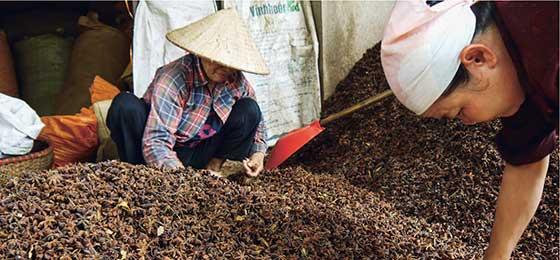The world of small things

What has the lunar calendar got to do with coal briquettes? The ethnologist Annuska Derks is investigating the journeys made by everyday things in South-East Asia. To this end, she's been researching in Vietnam.
(From "Horizons" no. 113 June 2017)
In Vietnam, coal briquettes are part of everyday life. But even such a widespread object isn't simply 'there'. Briquettes are manufactured, transported and traded – the livelihoods of many different people depend on them. I followed the journey of these briquettes, from the coal mines to households and street kitchens. I have spoken with more than 100 people – with workers at open-cast mines and in workshops by the banks of the Red River – and I have accompanied the traders who transport the briquettes on their bikes and rickshaws through the chaotic traffic of Hanoi. And I've sat next to the cooking pots that hang above the burning briquettes.
"My research goes beyond the actual object itself. The coal briquette is a means of analysing Vietnamese society. I have learnt a lot about the relationship between the state and the private sector, about the connections between housekeeping, gender and architecture and about the upswing in religious belief. And in the process of this, it became clear that abstract processes such as urbanisation, economic development and modernisation – and the inequality that results from them – can be observed all the way into the kitchen. Coal briquettes only began replacing wood as fuel in the 1980s, because the government wanted to stop deforestation. Briquettes quickly became popular because they fit in special ovens that you can easily take with you and set up anywhere. Meanwhile, their image has changed once more. Today, they're regarded as harmful to the environment.
A holistic view of society
"A single object can enable you to take a holistic view of a society. And there are surprises along the way. Briquettes are never bought on the first day of the lunar calendar, because that is supposed to bring bad luck (according to the yin-yang principle).
"Vietnam is a socialist country. The coal mines belong to the state, which exports most of its coal. You also find coal being washed into the open by the rain near where it's mined, and some of it lands on the roads while it's being transported. These pieces of coal are then gathered, mostly by women. This coal is of lesser quality and small workshops and family businesses compress it into special forms. The end product is a typical cylindrical coal briquette with several holes through it – the locals call it a 'beehive'. The traders fetch these briquettes on their converted bicycles or – more recently – on mopeds. I've accompanied them on their trips to their clients. Men and women trade with these briquettes – and women are traditionally very much part of the business.
A simple spice for flu vaccinations
"I had the idea for my current star anise project together with a colleague from McGill University in Montreal. She was researching mostly in the highlands of Vietnam, whereas my coal project was in the lowlands. It struck us that spices are something that unites these two regions. Star anise and other spices are cultivated in the highlands, harvested, and then transported to the lowlands where they are traded and processed or exported to China and India. Vietnamese cuisine also calls for star anise – it's part of the traditional recipe for the noodle soup pho.
"Using star anise, you can get a very good insight into the economic and societal development of Vietnam. The country changed after its reforms of 1986. The price of the spice rose a lot as a result of this, and this naturally had a big impact both on the region where it is cultivated and on its trade in general. Furthermore, star anise is interesting to the pharmaceutical industry. It contains shikimic acid, which is the active agent of the flu remedy Tamiflu. After the bird flu outbreak of 2005, demand rose sharply for Tamiflu, and so did the price of star anise. Afterwards, the price sank considerably again because other flu drugs came onto the market, and because the pharma industry was soon able to produce the agent artificially. These global changes have had a concrete impact on local people. Some farmers with whom I spoke have stopped harvesting their star anise trees. It is now too costly.
Recorded by Anne-Careen Stoltze